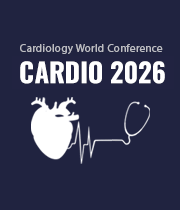Title : A serial case congenital heart repair: Successful device closure of a large ASD
Abstract:
Transcatheter Atrial Septal Defect (ASD) closure is now a widely recognised alternative to surgical closure for suitable secundum ASDs. We report a serial case closure of a large ostium secundum ASD (OS-ASD) which measured 35 mm and 40 on Transesophageal Echo (TEE) and was closed with a 42 and 46 mm device, respectively. A 24 year old woman and a 38 year old woman from Indonesia had complaints of shortness of breath on exertion and palpitations. On examination, they had a wide and fixed split of the second heart sound with a soft ejection systolic murmur over the left second and third intercostal spaces. Trans thoracic echo revealed a big OS ASD measuring 35 mm and 40 mm, respectively, with left-to-right flow and good biventricular function. The patient preferred a nonsurgical mode of treatment, and hence an ASD device closure was decided upon. TEE in the cath lab measured 35 mm and 40 mm OS ASD, respectively, with an adequate rim. Initial right heart catheterisation was done. In conclusion, ASD closure can be performed for these two patients. A 42 and 46 mm device was loaded using the standard technique in a 14 Fr delivery sheath. The device was placed in the right upper pulmonary vein (RUPV) with part of the left atrial disc in RUPV.
First the right atrial disc was delivered, following which the left atrial disc fell into its place, completely occluding the shunt. Device placement was checked with TEE, which showed no residual shunt and unobstructed flow across both the atrioventricular valves and systemic and pulmonary veins. Left ventricular end-diastolic pressure remained the same both before and after the device placement. The device was deployed under cine guidance. The patient tolerated the procedure well and was extubated on the table. He was given aspirin, which he was advised to continue for 6 months. He remained asymptomatic after the procedure; his device position was confirmed before discharge with no residual shunt or unobstructed flow across both the atrioventricular valves and systemic and pulmonary veins. On follow up he became asymptomatic without any complication, and they had planning for TTE evaluation for 1 month, 3 months, 6 months and 12 months after ASD closure by device and continued for every 12 months or if any complication was found.
With the improvement in technology, even very large ASDs can now be closed with the device. Balloon assisted dilator assisted device delivery are a few frequently used techniques for larger-size device deployment. In our patient the ASD device was delivered using the standard technique from the right upper pulmonary vein without using any balloon or dilator assistance. Though closure of OS ASD with a device is now a standard mode of treatment, there are few well known immediate, intermediate, and long term complications. The reported significant complications of device closure include cardiac perforations, device malposition or embolisation, residual shunts, vascular trauma, thrombus formation, atrioventricular valve regurgitation, aortic regurgitation, atrial arrhythmias, infective endocarditis, and sudden death. Patients have to be on lifelong follow up after device closure of their defect.




